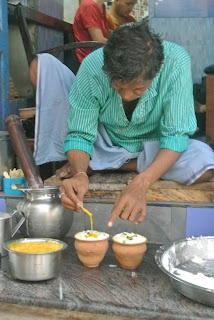Not once in the four days that I am there do I manage to find my way back to my hostel without taking a wrong turn and needing to ask for directions. I'm fairly sure that the streets shift just before I turn a corner, as I feel like I never walk down the same alley twice. The guide book advises 'if you get lost, head for the ghats'. This is easier said than done, what with being lost, but there is always someone to ask and even more people to tell you whether you ask or not. Eventually the alley spits me out into the bright sunshine onto rows and rows of steps, or ghats, leadings down to the filthy Ganges river.
Much of my time in Varanasi is spent walking up and down the ghats observing day to day life. The water of the Ganges is considered to an 'elixir of life' and bathing in it washes away the bather's sins. As such there is a continual stream of people pouring out of the alleys, down the steps and into the river to wash. This doesn't make much sense to me as, despite the river's historical religious significance, it is now filthy. More than filthy. There are dead animals, live animals, litter, unidentified scum and, apparentlty, the waste from a chemical plant up river all in the water. Whislt washing in it may metaphorically clean you of sin, physically it would make you dirtier (and less healthy) than before you went in.
For all the time I spend lost and wondering up and down the ghats, I spend about as much in 'Blue Lassi', a tiny hole-in-the-wall lassi shop which is famous in Varanasi. A 'lassi' is a yoghurt drink, usually served pain, salted or sweet. Blue lassi serve theirs wih fruit, and claim to have 'any fruit you want madam'. In reality there is mango, apple, pear, grape, pomegranate, banana, orange and papaya. Any combination of these can be requested, along with chocolate and coffee.
The lassis mixed up right on the side of the street and served in deep terracotta bowls. A man runs back and forth with fruits, ice and big trays of set yoghurt curd. The old man mixing the lassis seems very used to having his picture taken, and also works very quickly. When I ask, the 'runner' tells me that they go through about twenty to twenty-five dishes of yoghurt curd a day, each one making about twenty lassis. During my four days in Varanasi I have about seven lassis, several of them free as the owner recognises us after our second visit. As well as lassis we are given chai from the owner's mother's chai stall next door and handfuls of fruit everytime the runner goes past.








No comments:
Post a Comment